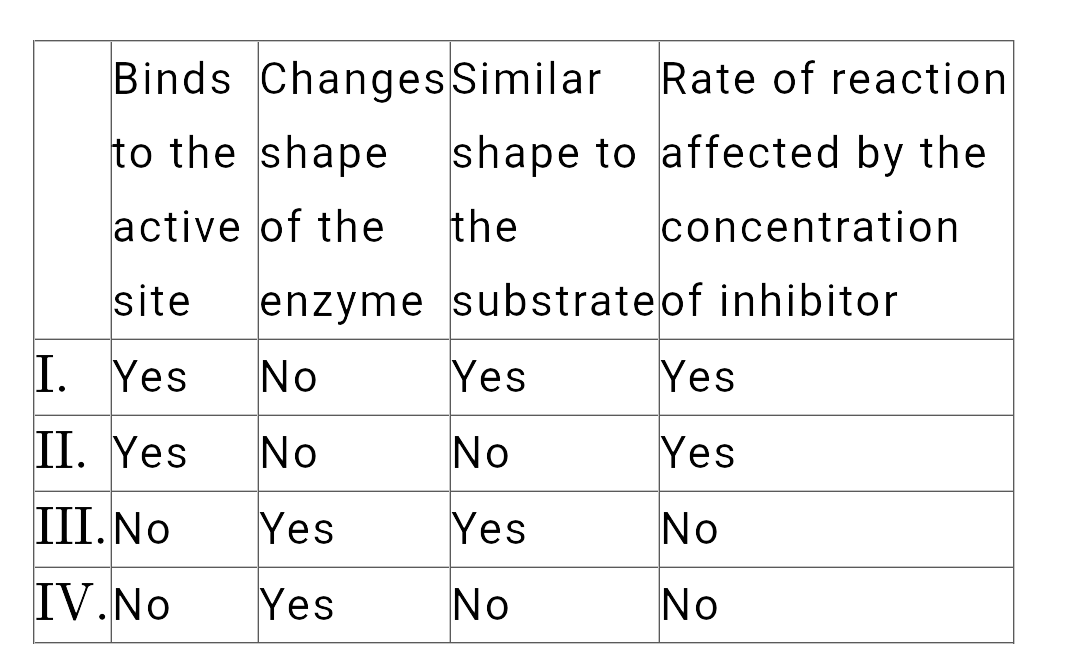In case of competitive inhibition of an enzyme,
Vmax is increased
km increased
Extent of inhibition remains the same in high substrate concentrations
None of the above
The correct Answer is:B
To understand competitive inhibition of an enzyme, let's break down the concepts step by step.
1. Understanding Enzyme Inhibition:
- Enzymes are biological catalysts that speed up chemical reactions. They can be inhibited by various molecules that interfere with their activity.
2. Types of Inhibition:
- There are three main types of enzyme inhibition: competitive, uncompetitive, and non-competitive inhibition.
- In competitive inhibition, an inhibitor competes with the substrate for binding to the active site of the enzyme.
3. Effect on Km and Vmax:
- Km (Michaelis-Menten constant): This is a measure of the substrate concentration required to reach half of Vmax. In competitive inhibition, the presence of the inhibitor increases the Km value because a higher concentration of substrate is needed to outcompete the inhibitor for binding to the active site.
- Vmax (maximum velocity): This is the maximum rate of the reaction when the enzyme is saturated with substrate. In competitive inhibition, Vmax remains unchanged because, at sufficiently high substrate concentrations, the effect of the inhibitor can be overcome.
4. Conclusion:
- In competitive inhibition, Km is increased (indicating a decrease in affinity for the substrate), while Vmax remains unaffected. Therefore, the correct answer to the question is that in competitive inhibition, Km is increased and Vmax is unaffected.
Final Answer:
- Km is increased, Vmax is unaffected.
- Enzymes are biological catalysts that speed up chemical reactions. They can be inhibited by various molecules that interfere with their activity.
- There are three main types of enzyme inhibition: competitive, uncompetitive, and non-competitive inhibition.
- In competitive inhibition, an inhibitor competes with the substrate for binding to the active site of the enzyme.
- Km (Michaelis-Menten constant): This is a measure of the substrate concentration required to reach half of Vmax. In competitive inhibition, the presence of the inhibitor increases the Km value because a higher concentration of substrate is needed to outcompete the inhibitor for binding to the active site.
- Vmax (maximum velocity): This is the maximum rate of the reaction when the enzyme is saturated with substrate. In competitive inhibition, Vmax remains unchanged because, at sufficiently high substrate concentrations, the effect of the inhibitor can be overcome.
- In competitive inhibition, Km is increased (indicating a decrease in affinity for the substrate), while Vmax remains unaffected. Therefore, the correct answer to the question is that in competitive inhibition, Km is increased and Vmax is unaffected.
- Km is increased, Vmax is unaffected.
Topper's Solved these Questions
- ANIMAL TISSUES BOOK - TRUEMEN BIOLOGY ENGLISHCHAPTER - ANIMAL TISSUES EXERCISE - MULTIPLE CHOICE QUESTIONS
193 Videos
- CELL- THE BASIC UNIT OF LIFE ( CELL AND ITS STRUCTURAL ORGANISATION )BOOK - TRUEMEN BIOLOGY ENGLISHCHAPTER - CELL- THE BASIC UNIT OF LIFE ( CELL AND ITS STRUCTURAL ORGANISATION )EXERCISE - MULTIPLE CHOICE ANSWER TYPE
308 Videos
Similar Questions
In competitive inhibition
View SolutionAn example of competitive inhibition of an enzyme is the inhibition of
View SolutionAn example of competitive inhibition of an enzyme is the inhibition of
View SolutionIn competitive inhibition the
View SolutionSelect the option with features that are applicable for a competitive inhibitor of an enzyme - catalyzed reaction .

View SolutionHow does competitive inhibition of an enzyme occur? How is such inhibition useful?
View SolutionCompetitive inhibition is due to
View SolutionIncrease in concentration of substrate in case of competitive inhibition results in
(a) No change in rate of reaction
(b) Increase in rate of reaction to original Vmax
(c) Decrease in Km value of the enzyme
(d) Both (b) & (c)
View SolutionWhat is the role of competitive inhibitor during enzyme action?
(a) It enhances enzyme action
(b) It declines enzyme action
(c) It alters the active site of the enzyme and prevents the binding of substrate
(d) it inhibits breaking of chemical bond of the substrate
View SolutionAn example of non-competitive inhibition is
View Solution
